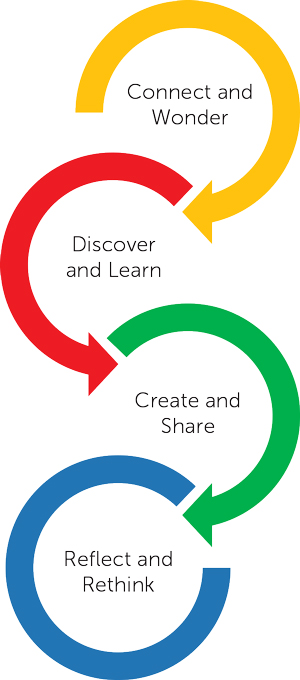Issue 92
Term 1 2015
Down the library path
Three teacher librarians from the Hunter region report on the planning to create an Information Skills Strategy and programme guide for the region based on the NSW DET Information Skills Process.
Three teacher librarians from the Hunter region report on the planning to create an Information Skills Strategy and programme guide for the region based on the NSW DET Information Skills Process.
When you are working with like-minded people sometimes the planets align and between you, clarity can be achieved.
The Hunter region has always had a strong professional body of Teacher Librarians (TL), gathering in small groups by region, education sector, and at the annual MANTLE conference. In 2006, the Hunter's TLs at the local Diocesan schools formed a group to create a Diocesan Information Skills strategy and accompanying programming guide that would provide consistency across the Diocese. The NSW Department of Education and Training's Information Skills Process (ISP) was used as the basis for creating the guide.
As time progressed, changes occurred that started a few of us thinking about the model:
- There was increasing discussion about Guided Inquiry and Inquiry models, with a focus on Inquiry in the incoming National Curriculum. Did we want to change the old model to 'fit' the new curriculum or did the new curriculum allow a move to a new way of thinking?
- The pedagogy and language of teaching was changing and our methods and strategies of teaching information literacy had been slowly changing too.
- We were looking for a model that reflected the language of the 21C learner/thinker/teacher.
- We wanted a model that used language that spoke to the age of the learners we were teaching and that could also be extended in a K-12 setting.
- We wanted a model that could encompass the new literacies being discussed – digital, visual, multi-modal.
- We were reading and discussing current research and ideas – Lee Crocket's work on 21st Century Fluencies, the International Society for Technology in Education (ISTE) Standards for students and teachers, and Microsoft's 21st Century Learning Design.
Individually a few TLs began exploring the new language and other inquiry models, eventually meeting as a small group, incorporating Catholic, Independent, and DEC Teacher Librarians to explore the new English curriculum and discuss a change of model.
It was evident to us initially that, whereas the skills we were teaching were becoming more relevant, the language of the ISP had begun to feel dated when talking to our students. We explored a range of Inquiry models looking at the language used for each step and whether it would meet our current needs. As we were teaching Inquiry to 5 to 11 year olds, we didn't want too many steps or language that would require explanation. The British Columbia Teacher Librarian Association 'Points of Inquiry' model provided some clarity for its simplicity and understandability but we weren't entirely happy.
Eventually we bit the bullet and amalgamated our ideas, reading, thinking, and planning to form the Library Learning Path (LLP) detailed below.
Connect and Wonder
What do I already know? What do I need to know?
This first step provides an opportunity for students to connect with their learning. This is a time for students to establish, and possibly share with the class, their existing knowledge on a topic. They will deconstruct their research question, or if required, create their own. It is a time to define terms and build keywords. The skills of questioning and concept mapping are often developed during this phase. It may be that the teacher, in collaboration with students, formalises the learning intention and teaching program after they have been through the process of connect and wonder.
Discover and Learn
Where can I find this information? Is the information necessary? How do I record this information?
This is the core research step. Students are required to locate, select, and organise their information. Students will develop the ability to identify keywords for searching and to use these effectively. They will be encouraged to search across a range of resource formats and they will develop the skills required to evaluate the resources found. It is important that students refer back to the learning intention of the lesson and redirect their research as required.

4 step Library Learning Path
Create and Share
Who is my intended audience? What tools could I use? How do I share this work?
Having gathered their information, students must now consider how to share this knowledge. This may be a decision made by the teacher and students must simply present their information as required. However, this step can instead be a wonderfully creative time, with students exploring new ways of presenting information to find one that suits their targeted audience. It is a perfect opportunity for students to develop skills in decision-making and communication. Students will often see this as the fun part! It is also a great time to explore new technologies.
Reflect and Rethink
What did I learn? What did I do well? What could I do better?
Reflection on the progress of a task should be occurring formally and informally throughout the learning process. As a formal step in the learning path, reflecting and rethinking at this point is more about evaluating the learning experience as a whole. Students will be encouraged to recognise the new skills they have learnt and consider where these might be used again. They might consider their personal work habits and identify areas of growth as well as areas to improve upon.
We made a conscious decision to have a 4 step process as simplicity, especially for younger students, was a focus. However, we realised that as student skill levels evolved and the complexity of tasks increased, a path with greater depth may be required. To meet this potential need, two optional steps were developed - Synthesise and Take Action.

6 step Library Learning Path
Synthesise
What are the key ideas? What does it all mean? What are the links and themes emerging across the information? What are my conclusions, decision, opinions?
The process of synthesising the information becomes important as students begin to draw on a broader range of resources when researching; as tasks are created incorporating higher order thinking; and a new meaning needs to be given to the information gathered. As students move into upper primary and high school, this ability to meld and apply information is crucial.
Take Action
How will I use what has been learnt? How can we use what has been learnt to bring a positive change to a situation?
This step supports 'real-world problem solving.' It gives authenticity to students' work, encouraging them to use the knowledge and skills developed through the program to make a difference in the world. This step takes the Library Learning Path from being an information process to being a true inquiry model.
So what does this look like when it is translated into the classroom? We knew that, as TLs, we incorporated all of the steps in every unit that we taught. But like the 'old' ISP, we wanted to focus on one or two aspects at a time within each unit.
The following is an example of a unit with a Year 2 class who were concentrating on vocabulary in their English/literacy lessons. It was thought that a closer look at onomatopoeia would be a good way to support the work being done in the regular classroom. The library time focus was on 'Create and Share.'
The program was broken up into three main areas:
1. Learning Intention:
To understand the use of vocabulary about familiar and new topics while experimenting with and beginning to make conscious choices of vocabulary to suit audience and purpose (EN1-7B).
2. Performance Task:
To write an onomatopoeic poem related to visuals from the teacher's photo bank and use PowerPoint and other tools to create a digital representation of their work.
3. Success Criteria:
The PowerPoint slide created by each pair of students had to contain one line of onomatopoeic text.
Before embarking on the unit, students engaged with texts containing onomatopoeic words and were asked to say them out loud. They were then asked to brainstorm in pairs, groups of 'sound' words related to a theme e.g. water, wind, sand. The term onomatopoeia was then introduced. This is where the students both 'Connected and Wondered' and 'Discovered and Learnt' by using prior knowledge of words and sounds as well as sharing of new words in their pairs. Students were asked how they might 'Create and Share' their work. After some discussion their ideas consolidated into using technology. This formed the basis of the Performance Task.
Using a variety of print, digital, and online media sources throughout the unit, students synthesised their knowledge into a short onomatopoeic poem based on the animals they had read about, looked at, and listened to.
The poems were uploaded onto PhotoPeach and, after viewing the results, students were asked to evaluate what they had done. This incorporated the 'Reflect and Rethink' part of the new process.
The use of the new learning process proved highly successful. Students responded with enthusiasm and curiosity throughout the unit because they were effectively given ownership of their learning through the use of these new, more relevant steps in the LLP. This enhanced their learning and also improved retention of what they learnt as they had been actively involved in 'Creating and Sharing' their knowledge.
References
- Crockett, L. Jukes, I. and Churches, A. 2012. Literacy is Not Enough; 21st Century fluencies for the digital age, Hawker Brownlow Education, Australia.
- McTigh, J. and Wiggins, G. 2011. Understanding by Design Guide to Creating High-Quality Units, Hawker Brownlow Education, Australia.
- NSW Department of Education and Training 2007, Information Skills in the School: engaging learners in constructing knowledge.
- British Columbia Teacher Librarian Association: Points of Inquiry [online] Available at: http://www.bctf.ca/bctla/pub/index.html#points
- Microsoft: 21st Century Learning Design [online] Available at: http://www.pil-network.com/pd/21CLD/Overview
Links
- Library Learning Path – MANTLE Conference (2014):
Prezi: http://bit.ly/1z9dixo
Support Documents: http://bit.ly/1kMLkg7


